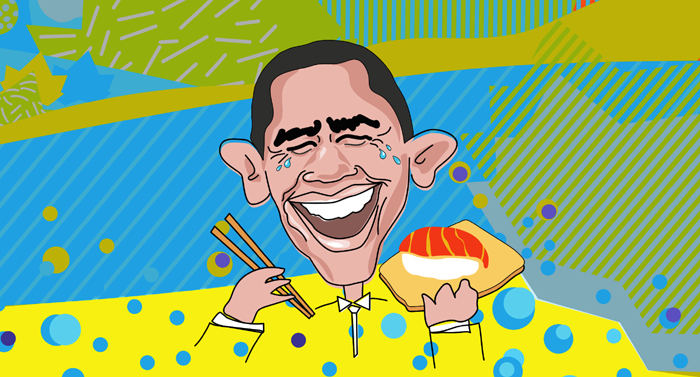
Blue Ocean is about using value innovation to reach new and untapped market. It sounds exciting, especially in today’s highly competitive environment and many companies are trying to pursue their Blue Ocean. However, not many are successful in creating Blue Ocean. Even for those who successful create their own Blue Oceans, they soon turn red. Companies usually cannot sustain what they create. Why?
The most common and observable explanation is: innovations are copied. The uncommon and hidden truth is something you may have never thought of: companies improve pain.
Build Up Your Competitive Advantage by Identifying Good Pain and Branded Pleasure
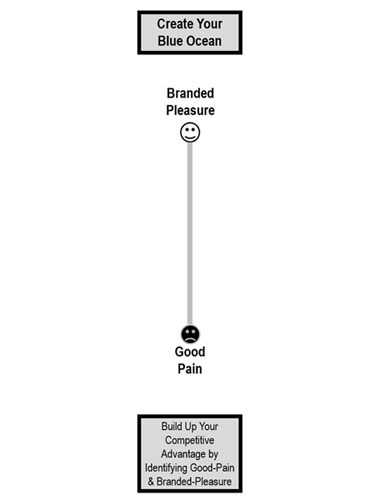
In the left diagram, you create your Blue Ocean by generating a significant pleasure peak for customers.
In this stage, particularly for the start-ups, you focus your energies and limited resources on what makes you succeed and stand out – your competitive advantage, and you disregard imperfections and defects you might generate. In other words, you build up your competitive advantage by identifying your Good Pain and Branded Pleasure.
The “Pain has to be Improved” Phenomenon
After creating their Blue Oceans, most companies move towards “Destructive Improvement.” When they go in this direction, their Blue Oceans are destroyed by the “pain has to be improved” phenomenon. This phenomenon is driven by the sacred belief of Continuous Improvement and Customer Centricity.
Continuous Improvement is the philosophy behind Kaizen, which preaches relentless continuous improvement, and the key systems dedicated to pursuing excellence, such as Six Sigma and Total Quality Management (TQM). Imperfections, pain and defects are the ‘devil’ and must be eliminated. Pain has to be improved.
Customer Centricity dominates in our modern commercial world. Customers’ voices ought to be heard, customers’ complaints must be addressed, and making customers suffer is an unforgivable sin. Pain has to be improved.
If you were the founder of a start-up who just opened a new Blue Ocean, or if you were a senior executive who successfully created a new distinctive competitive advantage in your industry, you would want to move forward, to build a stronger and bigger company. You might buy business books, attend conferences, or employ consulting companies. I’m sure two messages would come across from these field gurus, academics, technology vendors and management consultants. Always focus on Continuous Improvement and Customer Centricity. Pain has to be improved.
Destroy Your Blue Ocean by Improving Pain – Destructive Improvement
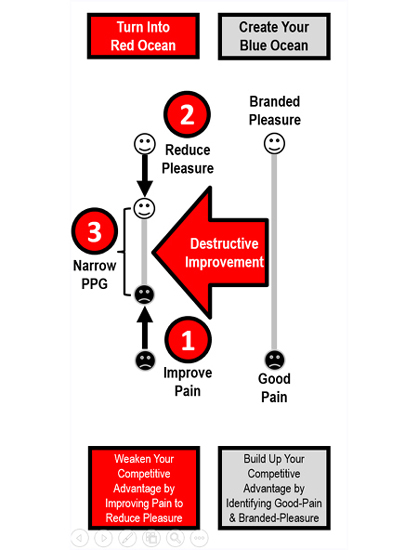
On one hand, you are being brainwashed by the “pain has to be improved” phenomenon, while on the other hand, no surprise here; your big innovation is attracting imitators.
Very few Blue Oceans are immune to copying; it is usually just a matter of time and effort. Internet and new technologies have sped up this process and made it easier. When your rivals imitate your offering, it lowers the pleasure peak perceived by customers.
The opportunity cost of improving pain is missing the golden time-window to further enhancing your Branded Pleasures by diluting your limited resource.
Using your resources more effectively than your competitors is a key to business success. Spend even a tiny amount improving something that does not give you the desired result and you are taking a step away from achieving a higher pleasure peak and a step closer to weakening your competitive advantage.
Even if you improve those things that are either important or painful to your customers, if they are not linked to your Branded Pleasures, it is destructive because it would eat up the resources of your Branded Pleasures, further lower the pleasure peaks for customers, make it look more like its competitors and be easier to copy. You waste your first-mover advantage.
Continuous Improvement turns into Destructive Improvement. The Blue Ocean becomes a Red Ocean.
Obama: “That’s some good sushi right there.”
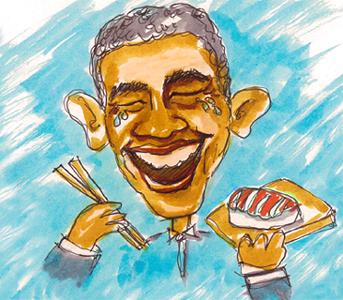
Sukiyabashi Jiro, a sushi restaurant located in Ginza, Tokyo has earned three Michelin stars for years (note 1). His restaurant is remote and difficult to find; it is in a basement, in a far-off district.
The seating area is tiny; it can hold a maximum of ten customers at a time. Jiro doesn’t accept walk-in customers and reservations have to be made more than a month in advance. The prices are steep; each customer pays more than 30,000 yen. His menu is fixed and with only a limited number of choices.
This sushi restaurant pushes pains to the extreme: tiny space, long wait for reservations, expensive, and almost no choice. But Jiro does make great sushi. He never diverges from this mission. Jiro focuses all his resources, attention and energies to make sushi. He does not expend resources improving anything we see as a pain. In fact, customer boast about waiting for a reservation and getting lost on the way to the restaurant; they even proudly tout the expense of the meal.
By aggravating those pains, the sushi restaurant is creating the highest possible pleasure peak for their customers – the best sushi in the world.
Yet Jiro has the highest Michelin ranking and his restaurant is always full. The place is so famous that U.S. President Barack Obama asked to dine there during his visit to Japan in 2014 (note 2).
Expand Your Blue Ocean by Aggravating Pain – Creative Aggravation
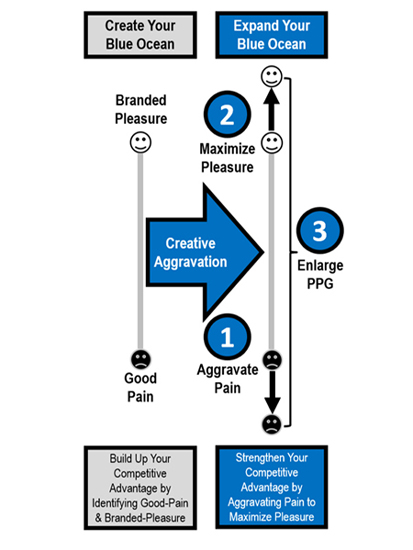
In sports, and really in any competition, we recall the champions, the ones who win the gold medals. It is the same in customers’ minds in business competition. To be the winner, you have to generate highest pleasure to customers.
To generate the highest possible pleasure peaks, you have to move towards Creative Aggravation. Not only not improve pain, you aggravate pain; imagine the tremendous resource that you could save by reallocating resource from Good Pains to Branded Pleasures.
You generate the most severe pain peaks – as far as they are not falling into the unacceptable levels of your customers – so you can heighten your pleasure peaks to unprecedented levels.
You make your company extremely difficult to imitate. You capitalize fully your first-mover advantage. You put your limited resources to their best use.
Creative Aggravation expands your Blue Ocean, reinforces your competitive advantage and transforms it into a sustainable strength by aggravating pain.
Great Brands have a Large Pleasure-Pain Gap
Great brands have two things in common: they generate an unprecedented level of pleasure to their customers to beat their rivals and eliminate imitators; they have a large Pleasure-Pain Gap (PPG) to maximize their resource productivity.
* Based on empirical data collected globally from 8,500 customers (note 3), Starbucks, IKEA and Louis Vuitton each has a large Pleasure Pain Gap (PPG).
* Based on 4,500 valid survey responses (note 4), China Merchants Bank (CMB) outperformed all 15 credit card issuing banks on all metrics, yet had the largest PPG among all major rivals.
* Based on the feedbacks of 757 IT managers (note 5), IBM has the most favorable B2B purchase experience as well as the largest PPG among 14 IT solution vendors.
* IKEA aggravates pain with DIY services to generate unmatched pleasure on good value for the money.
* Starbucks aggravates pain with premium pricing to create extraordinary pleasure with their “new coffee experience” and the Third Place.
* Louis Vuitton aggravates pain with the different service levels to deliver unprecedented pleasure with exclusivity.
* Southwest Airlines aggravated pain with no meals, entertainment, upgrades or reserved seats to offer knockout pleasure with cheap airfares.
* Jiro’s sushi restaurant aggravates pain on most aspects of the dining experience to render the utmost pleasure with the best sushi in the world.
All these industry leaders understand Creative Aggravation. They create the highest pleasure peaks to their customers by enlarging the Pleasure-Pain Gap.
Make a Paradigm Shift from “Improve Pain” to “Aggravate Pain”

The secret to eliminating imitators and expanding your Blue Ocean is to make a paradigm shift from “Improve Pain” to “Aggravate Pain.”
Strategy is about resource allocation. The effectiveness of a strategy is judged largely by the effectiveness in resource allocation. “Aggravate Pain” is undoubtedly a far more superior strategy because it uses resource more effectively than “Improve Pain.” There is no more better way to transform your competitive advantages into sustainable strengths without deploying extra resources: “Increase your PPG.”
Visually, when you narrow your Pleasure-Pain Gap (PPG), you destroy your Blue Ocean. When you increase your PPG, you expand your Blue Ocean. The height of a building is in proportion to the depth of its foundation. It is common sense, isn’t it?
Not many companies are successful in creating Blue Ocean, as it takes a unique combination of innovative thinking, wisdom and courage to invest resources differently.
However, making a paradigm shift from “Improve Pain” to “Aggravate Pain,” may require even more innovative thinking, wisdom and courage than creating your Blue Ocean in the first place. Only the most outstanding people understand this and are able to put it into practice.
NOTES
1. See Oldest Michelin Three Star Chef – Guinness World Records, retrieved 27 April 2014, from http://www.guinnessworldrecords.com/world-records/oldest-Michelin-three-star-chef.
2. See David Jackson, Obama: ‘That’s some good sushi right there.’ (USA Today, 23 April 2014).
3. Global Starbucks In-store Customer Experience Research, Global CEM and CustomerThink (U.S.), September-October 2007; Global IKEA In-store Customer Experience Research, Global CEM, CustomerThink (U.S.) and TOTE-M (Netherlands), December 2008-February 2009; Global Louis Vuitton In-store Customer Experience Research, Global CEM and CustomerThink (U.S.), October 2008.
4. Mainland China Credit Card Customer Experience Research, Global CEM, May-June 2008 and May-July 2009.
5. Mainland China B2B Purchase Experience (IT Solution) Research, Global CEM and CustomerCentric Selling (U.S.), July-August 2007.




For any reader of this article who feels uncomfortable to take the terms “pain” and “pain point”, which isn’t unusual, I would advice you to swap them with friction, effort, defect, valley, or imperfection – choose a substitute that you would accept to minimize the barriers for comprehending the genuine meaning and merits of enlarging the Pleasure-Pain Gap (PPG) and deploying Creative Aggravation.
Regardless of the term you use for the low points, it seems your main advice is that brands should strive to enlarge the gap between the highs and lows.
The Peak-End Rule says people tend to remember high points (because we humans tend to remember more intense or emotional events) and ending interactions (because of recency bias). There are a number of formal studies to support this theory.
https://en.wikipedia.org/wiki/Peak%E2%80%93end_rule
Focusing on peaks and ends makes sense.
I’m not aware of research that supports your theory that the size of the gap between peaks and valleys (pain, friction, whatever) is important. Your PPG is an interesting theory, but is there any research to support it?
My take is the gap must be big enough to recognize a peak. If every touchpoint is the same, then no peak. So I agree CX strategists shouldn’t waste resources to try to improve everything.
But you could have a noticeable peak with no pain of friction whatsoever. A touchpoint that was perceived as “delightful” would stand out versus other touchpoints that were just meeting expectations or satisfactory. Not memorable, but clearly different from the peak. Enlarging the gap by making the low point unsatisfactory just doesn’t make any sense to me.
Hi Bob, thanks for your comments and questions.
I will address them one by one:
1) Any research to support the theory of PPG
2) Why don’t just have a noticeable peak with no pain or friction
3) Making pain more painful doesn’t make any sense to you
Bob,
About your first comment / question: “Any research to support the theory of PPG”.
The essence of PPG is not related to any psychological principles (Peak-End Rule included). That’s why I didn’t mention any psychological principles in this article.
PPG is about RESOURCE ALLOCATION.
I’ve stated substantial evidences inside the article, e.g. Starbucks, IKEA, Louis Vuitton, China Merchants Bank and IBM with over 10,000 research data to support the theory of PPG, so I don’t repeat here.
When taking about why customers remember the pleasure peaks but disremember the pain peaks. Actually, most of the times customers don’t forget, they just forgive.
Customers won’t ‘suffer’ for nothing. The prerequisite is: there’re notable values for them to justify their sacrifices. It’s about VALUE EXCHANGE. I’ll elaborate it in my below reply.
Bob,
About your second comment / question: “Why don’t just have a noticeable peak with no pain or friction.”
Because we need Good Pains to support Branded Pleasures. That’s why the existence of both peaks and valleys is necessary.
For example, as a regular IKEA customer, performing DIY jobs is a pain point. Though I can understand why IKEA makes me ‘sweat’ – to channel the savings offering the best prices for their furniture and household items (IKEA’s brand purpose) – efforts are still undesirable; but it doesn’t stop me purchasing from IKEA, as far as the perceived VALUE (i.e. inexpensive prices) is larger than the endeavor (i.e. DIY services).
Likewise, being a loyal Starbucks customer, paying USD5 for a cup of coffee is a pain point. Despite I know why Starbucks has to charge premium prices – to create and maintain the Third Place (brand purpose of Starbucks) – high-priced coffee is nevertheless unwanted; but it wouldn’t prohibit me buying from Starbucks, to the extent that the perceived VALUE (i.e. the Third Place) exceeds the endeavor (i.e. premium prices).
On that ground, the DIY services of IKEA and premium prices of Starbucks are Good Pains and shouldn’t be eliminated, because they help generating substantial VALUES to customers – Branded Pleasures – which reflect the brand purposes of IKEA and Starbucks. The existence of Good Pains is to support Branded Pleasures. It is not about creating pains, it is EXCHANGING VALUES.
Without severe valleys (Good Pains), you won’t have significant peaks (Branded Pleasures).
Bob,
About your third comment / question: “Making pain more painful doesn’t make any sense to you.”
There’re two types of Pain Aggravation: Proactive and Passive.
Take, for example, Starbucks.
Based on the global Starbucks in-store experience research, the number one and two customer pain points are ‘pricing’ and ‘wait-time’(the research respondents are Starbucks repeat customers).
The premium prices of Starbucks could be a Good Pain. They need substantial financial resources to build up the Third Place.
Why ‘wait time’ could be a Good Pain? Because baristas can have sufficient time to greet, have eye-contact, interact and chat with customers – one of the Branded Pleasures of Starbucks which reflects their brand purpose – the Third Place.
As far as these Good Pains don’t fall into the unacceptable levels of their target customer, they should be allowed and are necessary.
When Starbucks raised their prices, it’s a “Proactive Pain Aggravation”.
However, most of the time, in a world when everyone is continuously improving, you don’t have to make pain more painful if you don’t improve.
Let’s assume the industry average of wait-time for coffee is 3-min. If all players dropped it down to 2-min and Starbucks doesn’t follow, when customers get used to the new norm – 2-min, Starbucks aggravate customer pain on wait-time. It’s a “Passive Pain Aggravation”.
I hope Pain Aggravation makes sense to you now.
The whole idea of PPG is neither creating pain for anchoring pleasure nor related to any psychological principles. It’s about channeling resources from Good Pains to Branded Pleasures.
It’s about RESOURCE ALLOCATION.
Sampson, thanks for your detailed comments. I feel I now have a good understanding of your theory.
Again, it appears you believe bigger gaps are better. Raising prices, increasing wait times, etc. — these are “pain” points that help the organization focus more resources on the pleasure “peaks.”
That makes complete sense. I used IKEA and Starbucks in my examples too.
What is still unclear is whether the size of the gap is related to success — higher satisfaction, revenue or some other business outcome. Your examples are great, but what I asked was whether you know of research (like Peak-End studies) that support your theory. If not, it may be a good opportunity to collaborate and do some research.
Your hypothesis appears to be that bigger gaps are better. Maybe, but what if Starbucks raised its prices to $10? 20$ $100? Does the experience continue to get better? Is Starbucks more and more successful as the price is raised, wait time increased, etc.
Perhaps it could happen if the $100 cup of coffee with an hour wait time results in not just a cup of coffee, but a performance by a favorite pop star.
My hypothesis is that gaps need to be “just big enough” for the peaks to be noticeable/memorable. I don’t know how big that is, but it would be interesting to find out. I also think there would be significant differences between industries. Perhaps utilities (where consistency is more valued than memorable moments) would be less likely to benefit from gaps than more discretionary purchases like coffee.
In any case, this has been a thought provoking discussion. I agree that more companies would be wise to try to create distinctive experiences, not just blindly “fix” everything that customers say is broken. In some cases that could indeed undermine the brand promise and actually be counterproductive.
Hi Bob, thanks for your response.
Too much of anything is bad, PPG won’t be an exception.
The proper extent of PPG has to fulfill two boundary conditions: one at the TOP one BOTTOM.
The TOP boundary condition: you’ve to have significant peaks (Branded Pleasures) to justify the severe valleys (Good Pains).
For example, if Starbucks couldn’t provide the current level of Third Place, they shouldn’t charge USD5 per cup of coffee. Because customers won’t pay for that.
The BOTTOM boundary condition: the severe valleys mustn’t fall into the unacceptable of your target customers.
Let’s say, if Starbucks raised their average prices to USD10 per cup of coffee, or with 10-min wait time, it will drive customers away.
Therefore, “Is Starbucks more and more successful as the price is raised, wait time increased” is not valid and won’t happen if the above two conditions are fulfilled.
I trust that after fulfilling the two boundary conditions, my idea of enlarging PPG won’t be much deviated from your hypothesis “just big enough”.
However, in the real world, the two boundary conditions are always in a dynamic mode, as customers’ tasting and competitors’ strategies are always changing.
It’d be difficult, if not impossible, to identify an absolute “Ideal PPG”. But research would help and is needed to dig out the relative “Ideal PPG”.
So yes, Bob, let’s work out something together!
I find your PPG theory very interesting & thought-provoking Samson. It would be great if you & Bob could collaborate on further research. This could change how companies approach CX!
Hi Kelechi,
Thanks for your nice words and encouragement.
CustomerThink and Global CEM have co-organized numerous CX research which generate considerable insights. I’d treasure any opportunity to join hands with Bob again to do something great!
I suggest that what you are calling pain is either 1) not painful, but pleasurable to its customers, or 2) part of the value trade-off that is acceptable for customers.
Take Sukiyabashi Jiro restaurant. I suggest that part of what you are describing as pain is actually pleasurable for its customers. They may enjoy the feeling of superiority and accomplishment from being able to 1) get a reservation, 2) find the restaurant, and 3) afford to eat there. I bet that if you substituted average sushi and served it at the same restaurant at the same high prices normally charged, people would like the Sushi the same as the expensive original. Post hoc justification of an expensive purchase? Who would not feel a little smug with being able to dine there?
Starbucks: Yes it is expensive, that price is definitely viewed as painful to many, but the Starbucks Experience, and the customization of one’s coffee choice, the convenience of many locations, the familiarity of attentive staff, and more makes it a pleasurable experience, an experience that is worth the expense, not worth the pain.
Ikea: Is putting together your furniture purchases a pain, yes, but it is a value trade off. You pay less and can transport your purchase easier. If Ikea offered the same product and the same price but included free delivery and assembly, would sales increase or decrease? The value would increase, not decrease. If the pain-pleasure gap was the factor important to the sales, then sales would drop if Ikea offered free delivery and assembly. I suggest that the feeling of accomplishment after assembly of an Ikea product is less than the convenience of having someone else do it for you.
Hi Terry,
Thanks for your questions. I summarized them into three issues as follow. Let me share my perspectives on them one by one.
1) Starbucks: a pleasurable experience that is worth the expense, not worth the pain.
2) IKEA: if they offered the same product and the same price but included free delivery and assembly, both the value and sales would increase, not decrease.
3) Sukiyabashi Jiro: an experience which is not painful, but pleasurable to its customers, and is part of the value trade-off that is acceptable for customers.
As the Jiro’s case involves something complicated, I’d address it at the end. Let’s start with Starbucks.
Hi Terry,
About the first issue – “Starbucks: a pleasurable experience that is worth the expense, not worth the pain.”
I think you may have missed my above reply to Bob Thompson. It’s NOT about creating pain, it’s about EXCHANGING VALUES:
“Being a loyal Starbucks customer, paying USD5 for a cup of coffee is a pain point. Despite I know why Starbucks has to charge premium prices – to create and maintain the Third Place (brand purpose of Starbucks) – high-priced coffee is nevertheless unwanted; but it wouldn’t prohibit me buying from Starbucks, to the extent that the perceived VALUE (i.e. the Third Place) exceeds the endeavor (i.e. premium prices).”
Based on the global Starbucks in-store experience research, the number one customer pain point is ‘pricing’. To the Starbucks customers, ‘the expense’ is a pain point – the pleasurable experience is worth ‘the pain’.
Hi Terry,
About the second issue – “IKEA: if they offered the same product and the same price but included free delivery and assembly, both the value and sales would increase, not decrease.”
Everything has a cost, delivery and assembly services of IKEA are no exceptions. Let me quote two examples:
If Starbucks maintained the same level of the Third Place, but significantly lowered their prices, both the value and sales would increase, not decrease.
If the ULLCs (ultra-low cost carriers) kept the same lowest airfares, but eliminated all price tags to every possible service item to include assigned seats, overhead bin space and even speaking with an agent, offered comfortable leg-room and inflight meals, both the value and sales would increase, not decrease.
Can you understand my point?
The Good Pain of IKEA is the DIY services and their Branded Pleasure is “good-value-for-money” furniture. The Good Pain of Starbucks is the premium prices and their Branded Pleasure is the Third Place. The Good Pain of ULCCs is all the lean-and-mean policies / attributes and their Branded Pleasure is the cheapest airfares.
The existence of Good Pains is to support Branded Pleasures.
Some CX experts always say they merely want peaks but take no valleys. But without severe pain points, you wouldn’t have significant pleasures.
Are some people so lacking of business and common senses that they can’t comprehend that “There is no free lunch”?
Hi Terry,
About the third issue – “Sukiyabashi Jiro: an experience which is not painful, but pleasurable to its customers, and is part of the value trade-off that is acceptable for customers.”
For the ‘value trade-off’, since I’ve explained it with the concept of “VALUE EXCHANGE” in my reply to your ‘second issue’, thus I don’t repeat here.
I agree with you that certain kinds of pain point can create pleasure to customers. As you stated in Jiro’s case: 1) get a reservation, 2) find the restaurant, and 3) afford to eat there.
That’s similar to the expensive prices or limited editions offered by premium brands, it’d create the pleasure of ‘exclusivity’ and ‘prestige feeling’.
Although creating pain point for anchoring pleasure works in some cases, it’s easy to abuse it or use it in a wrong way.
For example, some brands are generating pain points (e.g. create a problem) just for the sake of anchoring pleasures (render a solution to the problem) in an experience. Personally I am against this approach. For two reasons:
1) It is not ethical. Customers vote for your brand by giving your company their hard-earned money; they trust you. They should not expect to get in return ‘illusionary’ pleasure generated by playing some mind games and manipulating pains.
2) There is a much better option. By allowing or aggravating certain pain points (Good Pains), you channel the tremendous resource saved to further enhance your Branded Pleasures. You create ‘genuine’ values to your customers. In Jiro’s case, he focuses all the saved resources and his attention to produce the best sushi.
I don’t deny that psychological factor may play a role for perceiving his sushi the world’s best. As you quoted “Post hoc justification” to explain this phenomenon.
However, I’m not sure I agree with you on “if you substituted average sushi and served it at the same restaurant at the same high prices normally charged, people would like the Sushi the same as the expensive original.”
It could be dangerous if someone follows this direction for creating experiences. In my opinion, it is mistaken. As I said, it’s not ethical and there’s a much better option: Allow and aggravate the Good Pains to further enhance your Branded Pleasures.
If without significant pleasures – not only the feeling of exclusivity, but also the quality of sushi – customers wouldn’t tolerate the severe pain points.
There must be a reason why Jiro has earned three Michelin stars for years.